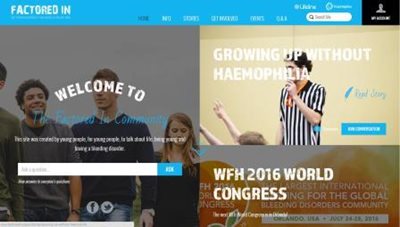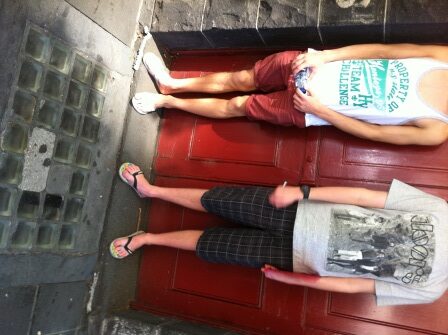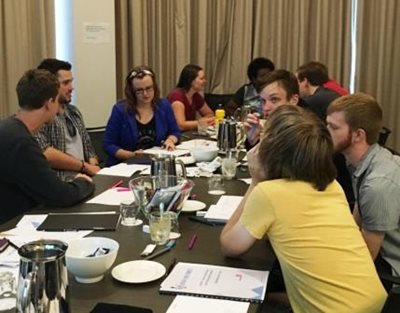HANNAH OPESKIN
Hannah Opeskin is Health Promotion Officer, Haemophilia Foundation Australia

The new Factored In has been launched!
The Factored In website has been remasted, redeveloped and relaunched with a brand new look! After extensive consultation with the Youth Working Group it was decided that Factored In needed a makeover in order to ensure that the site continued to be user friendly and reflect youth needs. The site now has some great features as well as a modern look, including a featured story and event on the homepage. It also has the latest news and events, and the latest polls for members to take part in!
Factored In is for people aged 13-30 who have a bleeding disorder, carry the gene or are a sibling of a person with a bleeding disorder. Here you can find good information, ask questions (even ones you’ve been too embarrassed to ask) – and if you’re a member, you can take part in competitions and polls, and comment on stories and share your own.
Becoming a member is easy and free with lots of perks – if you’re not a member yet and want to join the youth community, head over to Factored In and click on My Account to join!
If you are a current member you will need to create a new password by visiting http://www.factoredin.org.au/my-account/reset-password
I encourage everyone to head to www.factoredin.org.au to have a look!



The Haemophilia Foundation Australia (HFA) Beyond Prophylaxis youth project (2012) identified a lack of information and understanding about the needs of young Australians with bleeding disorders and a lack of resources to respond to their needs.
As a result, the Project aimed to involve young people in peer education and support, and to equip them with the life skills to manage the reality of living with a bleeding disorder in a positive and affirming way.
The Beyond Prophylaxis needs assessment identified that young people’s lives were changeable and demanding, but that they wanted to have ways to connect with others to share their experiences and give peer support. Beyond Prophylaxis led to leadership and mentoring training where youth could take on roles to support others in their local community or nationally. .
The Beyond Prophylaxis Project also recommended the development of an online tool where youth could share their stories, connect with the youth community and have access to youth specific evidence-based information; hence www.factoredin.org.au was born.

“[A major issue is] not knowing what is normal for haemophiliacs my age”
“[I would like] someone just to talk to about it and compare notes, and also prevent the feeling of being so different”
“As long as there is a way to communicate, we probably will”
“For me, talking to older haemophiliacs was by far the best way to find out more information and learn more about what was to come”
Many were consulted as part of the project: young people, parents, health professionals, Foundations. They identified reasons that young people with bleeding disorders might be isolated and “difficult to engage”: often because they prefer not to identify with having a bleeding disorder or with the bleeding disorders community, or do not find the community activities attractive or relevant to them.
Many of the health professionals talked of young people starting to disengage from haemophilia health services and community at around the age of 13-14 years and there being a life stage when many do not want to acknowledge their bleeding disorder. Even with a strong personal support network, a Youth Committee member described a ‘hating my haemo’ phase of his life during his teenage years.
The groups noted that isolation from peers with bleeding disorders and community could contribute to the sense of being alone and decrease opportunities for learning effective ways to manage their bleeding disorder from peers, community mentors or health professionals. With the potential for harm that could result from this, it is important to gain a better understanding of how to engage with these isolated and difficult to reach young people and what their current and future needs are.
To ensure peer communication, support and education is sustainable, an ongoing strategy would involve the further development of a leadership and mentoring program that provided skills in this area to a team of young people affected by bleeding disorders.

YLC training participants with Mantra

YLC participants brainstorming their hurdles
The Youth Lead Connect (YLC) program developed by HFA builds education and life skills for young people with bleeding disorders.
Application to the program followed a similar process to a job application: youth were required to submit an application form to HFA detailing why they wanted to be involved in the program and how they would use the skills learnt from the training in their local community, they were also required to provide a referee to support the plan.
This application process was important because it gave the participants the opportunity to reflect on their strengths and interests. It also meant that the program could be carefully tailored to the participants, taking into account their strengths and what they would like to develop further, their experiences, past training and interests. This meant the program could be pitched at a much higher level and build on their existing knowledge and experience.
Including referees from their local community was key to ensuring their local haemophilia foundation was able to support the youth participant. The HFA Health Promotion Officer spoke with applicants and their referees about their strengths and areas for further development and confirmed they would be included in the weekend leadership and mentoring workshop. .
The workshop was run in February 2015 and was engaging and inspiring for everyone who attended. Critical to the success of the entire weekend was the range of facilitators including the HFA educators, The FRANK Team and Reach with a variety of approaches and expertise to maintain engagement. Youth participants demonstrated that they were inspired to be part of the program and to be a leader or mentor in their community.
Participants were required to identify hurdles that they would complete as part of their training. The flow on effect of Youth Lead Connect is that it opened a dialogue between youth participants and their local haemophilia foundations and encouraged youth to be involved in local community events and activities. It also enables youth participants and their foundation to have a conversation about their personal strengths and interests and how this can be tailored to help their foundation with relevant and useful activities.
I am in regular communication with the youth participants and their local foundations to check all is going well as the youth work on their hurdles. When completed participants will provide a report about their hurdle.
It is exciting to hear of some of the outcomes and achievements so far:
We are currently evaluating the YLC program more formally. However, there has already been positive feedback and support from the community, providing momentum for the ongoing development of the program.
The Youth Lead Connect program is supported by an unrestricted education grant from CSL Behring.
Haemophilia Foundation Australia acknowledges the Traditional Owners and Custodians of Country throughout Australia, the land, waters and community where we walk, live, meet and work. We pay our respects to Elders past and present and extend that respect to all Aboriginal and Torres Strait Islander peoples.
Sign up for the latest news, events and our free National Haemophilia magazine